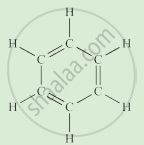Advertisements
Advertisements
प्रश्न
Element A has 2 electrons in its M shell. Element B has atomic number 7.
Write equations to show how A and B form ions.
उत्तर
\[\ce{A - 2e- -> A^2+}\] (cation)
\[\ce{B + 3e- -> B^3-}\] (anion)
APPEARS IN
संबंधित प्रश्न
List three characteristic properties of covalent compounds.
Explain the formation of a chlorine molecule on the basis of electronic theory of valency.
State one use of diamond which depends on its 'extraordinary brilliance' and one use of graphite which depends on its being 'black and quite soft'.
A hydrocarbon having one double bond has 100 carbon atoms in its molecule. The number of hydrogen atoms in its molecule will be
(a) 200
(b) 198
(c) 202
(d) 196
Give examples for the following:
Two gaseous polar compounds.
Compare the compounds carbon tetrachloride and sodium chloride with regard to solubility in water and electrical conductivity.
Electrons are getting added to an element Y:
which electrode will Y migrate to during the process of electrolysis?
Name greenish-yellow gas which also bleaches.
Answer the following question.
What is methane? Draw its electron dot structure. Name the type of bonds formed in this compound. Why are such compounds:
(i) poor conductors of electricity? and
(ii) have low melting and boiling points? What happens when this compound burns in oxygen?
Complete the following activity.
Write the names of the hydrocarbons for the following structural formula.
(isobutylene, cyclohexane, propene, cyclohexene, cyclopentane, benzene, propyne, isobutane, propane)
 |
